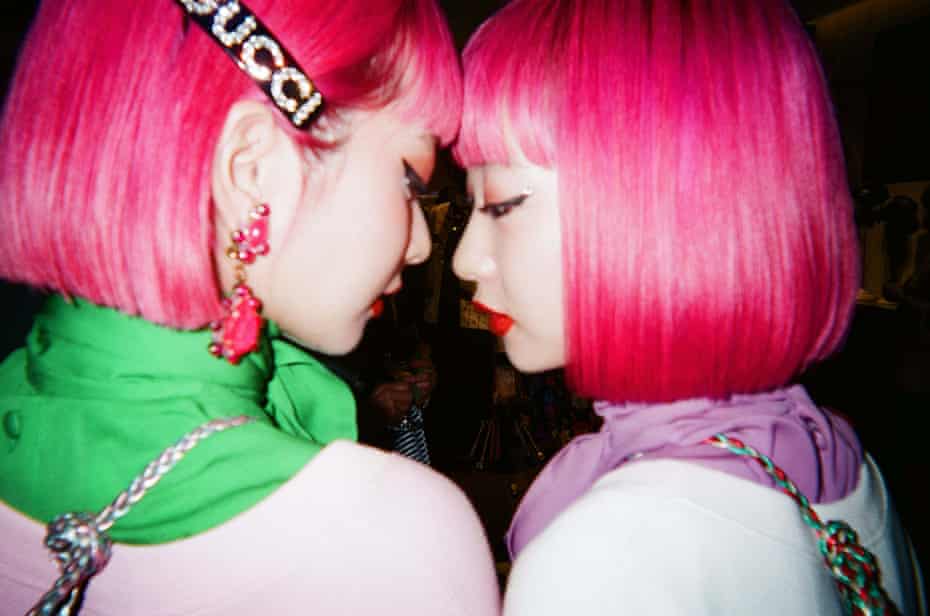Tokyo review – lust and loneliness in Japan’s pleasure quarters

Thrilling ... an image from Tokyo: Art & Photography at Ashmolean Museum, Oxford. Photograph: Mika Ninagawa
Ashmolean Museum, Oxford
A seductive encounter with past and present at the Olympic city shows that Tokyo practically invented modern art

Jonathan Jones
Wed 28 Jul 2021 02.33 AEST
Love hotels and cross-dressers make Tokyo’s nightlife eye-popping – and that’s just in 18th-century woodblock prints. The Ashmolean’s seductive overview of the Olympic city’s art sets these classics alongside images of contemporary Tokyo to create a thrilling and informative encounter with one of the world’s great art capitals.
Past and present meet for a sultry encounter in the night. A wall is lit up by Mika Ninagawa’s intensely coloured photos of blue- and pink-haired clubbers. They are so now – yet close by in the same gallery is a painted scroll from the 1600s that is just as provocative. It depicts the pleasure quarter of Edo, as Tokyo was then called, which became Japan’s capital when the Tokugawa shoguns united the country in the 17th century. It was famous for its pleasure quarter, “the floating world”, and the new art genre it inspired – ukiyo-e, “pictures of the floating world”. In the scroll, samurai warriors are seen visiting courtesans. But samurai were banned from the pleasure quarter so they wear straw hats pulled down to hide their faces. The comically phallic swords peeping out from their robes give them away.
This exhibition joyously demonstrates that Tokyo’s artists and photographers are still making pictures of the floating world. Tokyo Rumando photographs herself in love hotels, the sexual retreats first popularised in 1960s Tokyo for couples who needed to get away for a night from multigenerational family homes. Rumando poses alone, imagining herself as a guest, exploring fantasies yet also evoking solitude. In one picture, she sits in her underwear and stockings astride a plastic horse, by herself in a BDSM dungeon. Love hotels are plainly photographic gold: Kyoichi Tsuzuki also photographs them, taking us into gorgeously over-the-top kitsch boudoirs. And again the past comes in flirtatiously. Beside these photos of nocturnal Tokyo are explicit woodblock prints of 18th- and 19th-century sex workers and their clients that are convolutions of flowing robes and entangled limbs.
 Doll Festival, 1966, by Shinohara Ushio Photograph: Ashmolean Photo Studio/© Ushio and Noriko Shinohara
Doll Festival, 1966, by Shinohara Ushio Photograph: Ashmolean Photo Studio/© Ushio and Noriko ShinoharaAdvertisement
But it’s not all pleasure quarters. Ryūji Miyamoto’s photobook Cardboard Houses records the lengths to which homeless people in 1990s Tokyo went to construct some kind of home: a tent with a cardboard door in the bushes above a busy road, a house made of found materials including a huge umbrella. Urban squalor is more comically explored by artists Chim↑Pom in their encounters with Tokyo’s “super rats”. A stuffed rat stands boldly on its hind legs. On video, the artists run around at night catching rats with fishing nets.
The city is a dangerous, socially extreme, dirty place, but most of all, it can be so lonely. Meiro Koizumi’s video My Voice Would Reach You is heartbreaking. A man stands in a busy Tokyo street trying to phone his dead mother. He keeps dialling various companies and helplines, addressing anyone who answers as his mother. He’s constantly rebuffed by baffled strangers at the other end of the call. Meanwhile, the crowds pour past him.
This too has roots in Edo/Tokyo’s art history. The greatest works of art here are dazzling prints from Utagawa Hiroshige’s 1856-58 series One Hundred Famous Views of Edo. They depict, with cool modernity, the anomie and randomness, as well as the fleeting beauties, of big city life. In one scene, people trudge across a wooden bridge in a brutal rain storm: they huddle under their umbrellas, city people making their way to who knows where, while strangers pass them by in the rain. A man on the river is even more alone, isolated in space on a raft.
 A print of Edo in Tokyo: Art & Photography. Photograph: Edo
A print of Edo in Tokyo: Art & Photography. Photograph: EdoAdvertisement
You can see why Vincent van Gogh found this rain-beaten view of urban existence so moving when the lonely Dutchman was living in Paris. He painted a copy of Sudden Shower at Ohashi Bridge, Atake that is today in the Van Gogh Museum. It was part of a passion for Japan’s art that inspired avant garde artists in 19th-century Europe to revolutionise the way they saw cities, from Manet to Whistler to Pissarro.
But this exhibition puts the European moderns in their place. To see how they ransacked Hiroshige, you’d think he was some long-ago, anonymous, primitive artist. In fact his Famous Views of Edo were only created around 1857, a few years before the impressionists appropriated him – and these sophisticated scenes come out of a tradition of urban art that was already well-established in Tokyo. If Tokyo’s artists today are so good at inhabiting modern life in all its strangeness, that might be because their city has a great tradition of doing it.
Long before Paris and New York became capitals of modernity, the floating world pictures of old Edo first defined what is beautiful, scary and liberating about life in the big city. Tokyo triumphs here as the place that invented modern art when samurai swords were cutting-edge technology.
Tokyo: Art & Photography is at Ashmolean Museum, Oxford, from 29 July to 3 January.
No comments:
Post a Comment